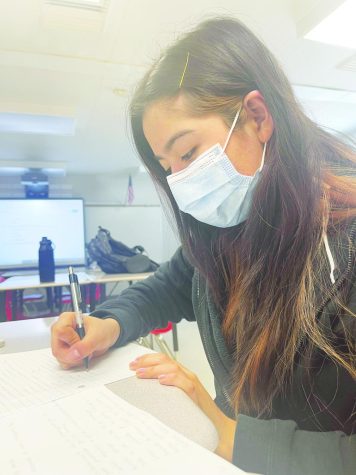This winter, stay on the lookout for SAD
During these cold winter months, students may start to have trouble focusing in class and getting sleep. Some people may call this the winter blues, but it may be a much more serious case of Seasonal Affective Disorder (SAD). This is a form of seasonal depression associated with the change of the seasons. It most commonly begins in fall or winter after daylight savings time when the days are shorter.
The symptoms for SAD include losing interest in activities you once enjoyed, constant low energy, trouble sleeping, changes in your appetite or weight, difficulty focusing, feeling sluggish or agitated, difficulty concentrating, feeling hopeless, worthless or guilty and having frequent thoughts of death or suicide. Expressing and feeling emotions such as sadness is normal. However, if it is constant and you begin to lose interest in activities you once enjoyed, it may be a good idea to get a doctor’s opinion.
Since during the winter there is reduced sunlight, it can start a drop in levels of serotonin, a brain chemical (neurotransmitter) which helps manage your mood. There are many other explanations for the cause of SAD, one of which being the production of melatonin. The production of melatonin is made to help make you sleep, when sunlight occurs it prompts the brain to stop in order for you to feel awake and vigilant. However since during winter there are short days and long nights, your body may get confused and produce too much melatonin which can cause you to feel sluggish or drowsy.
The good news is that SAD is curable and not permanent. Other than going to the doctor and medication, there are other ways to recover and put an end to the negative emotions you’re feeling. First, get as much sunlight as you can. When receiving sunlight, your body boosts serotonin levels and your mood increases. Start off by sitting outside, perhaps on your porch, and reading a book or painting. Slowly move on by going on walks with friends or family. Some people have discovered that repainting their homes to brighter colors helps fight SAD.
Another method to help overcome SAD is by exercising regularly. Exercise has been shown to treat mild to moderate depression just as effectively as antidepressant medication. Exercising regularly can increase endorphins, dopamine, adrenaline and endocannabinoid (brain chemicals which help make you feel happy). It’s recommended by health officials that kids and teenagers get an hour of exercise daily and adults get half an hour. The most beneficial exercises for depression are walking, weight training, swimming, martial arts or exercises where you move both your arms and legs.
Along with exercising, eating right also plays a major role in overcoming SAD. The symptoms of SAD may cause you to crave more unhealthy and fatty foods but by eating healthier, you can boost your feel-good serotonin levels. Foods which provide omega-3 fats such as nuts and seeds, flaxseed, chia seeds and walnuts can improve your mood significantly.
Talking to friends and family is an important key to helping get over any serious mental health issue. It is essential to have a strong support system when going through a depressive disorder. Creating and maintaining close relationships with others is necessary to helping you control SAD. Participating in social activities can give you a feeling of self worth and acceptance. Try to call or email a friend or family member to meet, join a support group, or volunteer your time. Giving back to your community activates your mesolimbic system (brain’s reward center) which releases endorphins making you feel happy.
There are many mental health resources here at AHS available for students to take advantage of, if needed. School Psychologist Laurie Ottenhenning encourages students to seek help as soon as you notice that you are feeling depressive symptoms, rather than waiting and letting those symptoms get worse.
“Since SAD is a type of depression, the treatment is often the same. Most people with depressive symptoms benefit from treatments like therapy and/or medication. You can also utilize any other healthy coping skills that typically help you when you are struggling: things like FaceTiming friends, getting enough sleep, exercising, and getting outside during the daylight,” Ottenhenning said.
It’s important to stay positive especially during these tough times with the pandemic. Staying home for long periods of time may be frustrating, but it’s important to remember to take mental health breaks and check up on your friends. Pandemics are likely to cause an increase in fear and anxiety. Social distancing may make some feel lonely and isolated which can increase stress and anxiety which may lead to other serious mental health issues. It’s understandable to be feeling these emotions in our current situation. However, it is necessary that you cope with these emotions in a healthy way.
“Dealing with COVID for this long has already increased many peoples’ feelings of anxiety and depression. Any mental health difficulties related to COVID could exacerbate SAD symptoms, like feeling hopeless, socially isolated, and unmotivated. It is obviously important to continue to follow all of the health and safety guidelines right now to reduce the spread of COVID, but you can still engage in healthy self-care activities, interact with your friends virtually and get therapy and other treatments if needed.” Ottenhenning said.
Seasonal Affective Disorder is a serious disorder that can affect you or your loved ones. The first step to beating it is identifying and accepting it.
If you or someone you know is in immediate distress or is thinking about hurting themselves, call the National Suicide Prevention Lifeline toll-free at 1-800-273-TALK (8255) or the toll-free TTY number at 1-800-799-4TTY (4889). You also can text the Crisis Text Line (HELLO to 741741) or go to the National Suicide Prevention Lifeline website.

Sophomore Mariamawit Endalkachew is a second-year staff writer on The A-Blast. In her free time, she enjoys spending time with her friends and watching...










